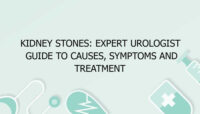Prostatitis: Causes, Symptoms & Treatment
Prostatitis is an inflammation of the prostate gland, a small organ located below the bladder and in front of the rectum, which plays a key role in the male reproductive system. This condition can cause significant discomfort and impact quality of life. Understanding the causes, symptoms, and treatment options for prostatitis is crucial for effective management and relief.
Causes of Prostatitis
Prostatitis can result from various factors, and its causes are often classified into different types:
1. Acute Bacterial Prostatitis:
- Bacterial Infection: Acute bacterial prostatitis is usually caused by a bacterial infection, often stemming from bacteria that enter the prostate gland through the urethra. Common pathogens include Escherichia coli (E. coli), Klebsiella, and Proteus. This form of prostatitis is considered a medical emergency and requires prompt treatment.
2. Chronic Bacterial Prostatitis:
- Persistent Infection: Chronic bacterial prostatitis is less common but results from a persistent bacterial infection that is not fully eradicated. It may occur due to inadequate treatment of an initial infection or re-infection.
3. Chronic Prostatitis/Chronic Pelvic Pain Syndrome (CP/CPPS):
- Unknown Causes: The exact cause of CP/CPPS is often unclear and can be due to a combination of factors, including autoimmune responses, pelvic floor muscle dysfunction, or previous infections. This type is the most common form of prostatitis and can be further classified into inflammatory and non-inflammatory subtypes.
4. Acute Prostatitis:
- Inflammatory Response: Acute prostatitis can occur without a bacterial infection and may be due to non-infectious causes such as trauma or an inflammatory response. This type can also be related to other conditions affecting the prostate.
5. Chronic Non-Bacterial Prostatitis:
- Idiopathic: This form of prostatitis does not involve bacterial infection and may result from factors like stress, chronic inflammation, or previous injury. It is often categorized into inflammatory and non-inflammatory types, with no clear infection or identifiable cause.
Symptoms of Prostatitis
The symptoms of prostatitis can vary depending on the type and severity of the condition. Common symptoms include:
- Pain: Pain is a hallmark symptom of prostatitis and can be localized to the lower abdomen, lower back, perineum (the area between the scrotum and anus), and pelvic area. Pain may also be felt during urination or ejaculation.
- Urinary Symptoms: Individuals with prostatitis often experience urinary symptoms such as frequent urination, urgent need to urinate, painful or burning sensation during urination, and difficulty starting or stopping urine flow. There may also be a sensation of incomplete bladder emptying.
- Sexual Dysfunction: Prostatitis can lead to sexual problems, including painful ejaculation, reduced libido, and erectile dysfunction. These issues can be both a cause and effect of the discomfort associated with prostatitis.
- Systemic Symptoms: In cases of acute bacterial prostatitis, systemic symptoms such as fever, chills, and malaise may be present. Acute prostatitis can also cause nausea and vomiting.
- Chronic Symptoms: Chronic prostatitis or CP/CPPS often presents with persistent pelvic pain or discomfort that lasts for at least three months. Symptoms may fluctuate in severity and can significantly impact daily activities and quality of life.
Diagnosis of Prostatitis
Diagnosing prostatitis involves a combination of medical history, physical examination, and diagnostic tests:
- Medical History: A detailed medical history is essential to understand symptoms, onset, and any potential risk factors or previous infections.
- Physical Examination: A digital rectal exam (DRE) is often performed to assess the size, shape, and tenderness of the prostate gland. During this examination, the doctor may note any abnormalities or signs of inflammation.
- Laboratory Tests: Urinalysis and urine culture may be conducted to identify the presence of bacteria and determine the appropriate antibiotic treatment if a bacterial infection is suspected. Blood tests may also be performed to assess overall health and identify any systemic infection.
- Imaging Studies: Ultrasound or other imaging studies may be used to visualize the prostate and rule out other conditions such as abscesses or prostate enlargement.
- Prostate Secretions: In some cases, prostatic secretions may be obtained and analyzed for the presence of bacteria or inflammatory cells.
Treatment Options for Prostatitis
Treatment for prostatitis varies based on the type and severity of the condition. Options may include:
1. Antibiotic Therapy:
- Acute Bacterial Prostatitis: Immediate treatment with antibiotics is essential to address bacterial infections. Intravenous antibiotics may be required in severe cases, followed by oral antibiotics for several weeks.
- Chronic Bacterial Prostatitis: Long-term antibiotic therapy is often necessary to eradicate the infection. A full course of antibiotics based on sensitivity testing is crucial for effective treatment.
2. Pain Management:
- Analgesics: Over-the-counter pain relievers, such as acetaminophen or ibuprofen, can help alleviate pain and discomfort associated with prostatitis.
- Alpha Blockers: Medications like alpha blockers may be prescribed to relax the muscles around the prostate and bladder neck, improving urine flow and reducing pain.
3. Anti-Inflammatory Medications:
- Nonsteroidal Anti-Inflammatory Drugs (NSAIDs): NSAIDs can help reduce inflammation and alleviate pain associated with prostatitis.
4. Lifestyle and Home Remedies:
- Dietary Adjustments: Avoiding spicy foods, caffeine, and alcohol may help reduce irritation and symptoms associated with prostatitis.
- Warm Baths: Taking warm baths or using a heating pad can provide relief from pelvic pain and discomfort.
- Hydration: Drinking plenty of water can help flush out bacteria and reduce urinary symptoms.
5. Physical Therapy:
- Pelvic Floor Exercises: Physical therapy focusing on pelvic floor exercises may help alleviate symptoms of chronic prostatitis and improve muscle function.
6. Stress Management:
- Relaxation Techniques: Managing stress through relaxation techniques, such as mindfulness, yoga, or counseling, can help address the psychological aspects of chronic prostatitis.
7. Surgical Interventions:
- Prostate Surgery: In rare cases where prostatitis is associated with complications such as abscess formation or significant obstruction, surgical intervention may be necessary.
Recovery and Follow-Up
Recovery from prostatitis varies depending on the type and treatment approach:
- Acute Bacterial Prostatitis: With appropriate antibiotic treatment, symptoms usually improve within a few days to weeks. Follow-up appointments may be necessary to ensure complete resolution of the infection and monitor for any complications.
- Chronic Prostatitis: Management of chronic prostatitis may involve long-term treatment and ongoing follow-up to address persistent symptoms and improve quality of life.
- Lifestyle Changes: Adopting lifestyle changes and home remedies can contribute to symptom relief and overall well-being.
Frequently Asked Questions
- What is prostatitis?
Prostatitis is an inflammation of the prostate gland, which can cause pain, urinary symptoms, and sexual dysfunction. It can be caused by bacterial infections or other factors. - What are the common causes of prostatitis?
Common causes include bacterial infections (acute and chronic), non-bacterial inflammation, pelvic floor dysfunction, and other underlying health conditions. - What are the symptoms of prostatitis?
Symptoms include pelvic pain, painful urination, frequent urination, painful ejaculation, and systemic symptoms like fever in cases of acute bacterial prostatitis. - How is prostatitis diagnosed?
Diagnosis involves a medical history review, physical examination (including a digital rectal exam), laboratory tests (urinalysis and urine culture), and imaging studies if necessary. - What treatments are available for prostatitis?
Treatments include antibiotics for bacterial prostatitis, pain management with analgesics and anti-inflammatory medications, lifestyle changes, physical therapy, and in some cases, surgical interventions. - Can lifestyle changes help manage prostatitis?
Yes, lifestyle changes such as avoiding irritants (e.g., spicy foods, caffeine), staying hydrated, and practicing stress management techniques can help alleviate symptoms. - Is prostatitis a common condition?
Prostatitis is relatively common, particularly among middle-aged and older men. Chronic prostatitis or chronic pelvic pain syndrome is the most frequently encountered type. - Can prostatitis lead to complications?
In severe cases, prostatitis can lead to complications such as abscess formation, urinary retention, or chronic pelvic pain. Early treatment is important to prevent complications. - How long does it take to recover from prostatitis?
Recovery time varies depending on the type of prostatitis and treatment. Acute bacterial prostatitis typically improves within a few weeks with antibiotics, while chronic prostatitis may require ongoing management. - When should I seek medical help for prostatitis?
Seek medical help if you experience symptoms such as persistent pelvic pain, difficulty urinating, or pain during ejaculation. Prompt evaluation and treatment are important to manage symptoms and address any underlying issues.


